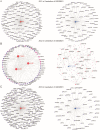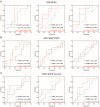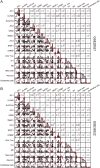Identification and Analysis of ZIC-Related Genes in Cerebellum of Autism Spectrum Disorders
- PMID: 38410689
- PMCID: PMC10895985
- DOI: 10.2147/NDT.S444138
Identification and Analysis of ZIC-Related Genes in Cerebellum of Autism Spectrum Disorders
Abstract
Objective: Autism spectrum disorder (ASD) is a complex neurodevelopmental disorder with significant genetic heterogeneity. The ZIC gene family can regulate neurodevelopment, especially in the cerebellum, and has been implicated in ASD-like behaviors in mice. We performed bioinformatic analysis to identify the ZIC gene family in the ASD cerebellum.
Methods: We explored the roles of ZIC family genes in ASD by investigating (i) the association of ZIC genes with ASD risk genes from the Simons Foundation Autism Research Initiative (SFARI) database and ZIC genes in the brain regions of the Human Protein Atlas (HPA) database; (ii) co-expressed gene networks of genes positively and negatively correlated with ZIC1, ZIC2, and ZIC3, Kyoto Encyclopedia of Genes and Genomes (KEGG) pathway enrichment, and receiver operating characteristic (ROC) curve analysis of genes in these networks; and (iii) the relationship between ZIC1, ZIC2, ZIC3, and their related genes with cerebellar immune cells and stromal cells in ASD patients.
Results: (i) ZIC1, ZIC2, and ZIC3 were associated with neurodevelopmental disorders and risk genes related to ASD in the human cerebellum and (ii) ZIC1, ZIC2, and ZIC3 were highly expressed in the cerebellum, which may play a pathogenic role by affecting neuronal development and the cerebellar internal environment in patients with ASD, including immune cells, astrocytes, and endothelial cells. (iii) OLFM3, SLC27A4, GRB2, TMED1, NR2F1, and STRBP are closely related to ZIC1, ZIC2, and ZIC3 in ASD cerebellum and have good diagnostic accuracy. (iv) ASD mice in the maternal immune activation model demonstrated that Zic3 and Nr2f1 levels were decreased in the immune-activated cerebellum.
Conclusion: Our study supports the role of ZIC1, ZIC2, and ZIC3 in ASD pathogenesis and provides potential targets for early and accurate prediction of ASD.
Keywords: ZIC1; ZIC2; ZIC3; autism; biomarkers; cerebellum.
© 2024 Li et al.
Conflict of interest statement
The authors declare that they have no competing interests.
Figures






Similar articles
-
Expression of the zic1, zic2, zic3, and zic4 genes in early chick embryos.BMC Res Notes. 2010 Jun 16;3:167. doi: 10.1186/1756-0500-3-167. BMC Res Notes. 2010. PMID: 20553611 Free PMC article.
-
The expression of the mouse Zic1, Zic2, and Zic3 gene suggests an essential role for Zic genes in body pattern formation.Dev Biol. 1997 Feb 15;182(2):299-313. doi: 10.1006/dbio.1996.8449. Dev Biol. 1997. PMID: 9070329
-
Zic Family Proteins in Emerging Biomedical Studies.Adv Exp Med Biol. 2018;1046:233-248. doi: 10.1007/978-981-10-7311-3_12. Adv Exp Med Biol. 2018. PMID: 29442325 Review.
-
Identification and characterization of Zic4, a new member of the mouse Zic gene family.Gene. 1996 Jun 26;172(2):291-4. doi: 10.1016/0378-1119(96)00111-4. Gene. 1996. PMID: 8682319
-
ZIC1 Function in Normal Cerebellar Development and Human Developmental Pathology.Adv Exp Med Biol. 2018;1046:249-268. doi: 10.1007/978-981-10-7311-3_13. Adv Exp Med Biol. 2018. PMID: 29442326 Review.
References
-
- Maenner MJ, Warren Z, Williams AR, et al. Prevalence and characteristics of autism spectrum disorder among children aged 8 years - autism and developmental disabilities monitoring network, 11 sites, United States, 2020. MMWR Surveill Summ. 2023;72(2):1–14. doi:10.15585/mmwr.ss7202a1 - DOI - PMC - PubMed
LinkOut - more resources
Full Text Sources
Research Materials
Miscellaneous

